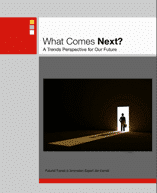 Clearly the rate of change – whether with business models, product life-cycles, skills and knowledge – is speeding up. With such change, there’s a lot of uncertainty within many industries as to what to do next: a senior executive of one client commented to me from his perspective, “…entities are engaged in survival tactics because they don’t know what to do next …”
Clearly the rate of change – whether with business models, product life-cycles, skills and knowledge – is speeding up. With such change, there’s a lot of uncertainty within many industries as to what to do next: a senior executive of one client commented to me from his perspective, “…entities are engaged in survival tactics because they don’t know what to do next …”
Innovation is all about adapting to the future – and if the future is coming at you faster, then you need to innovate faster. Innovation shouldn’t be about trying to survive the future – it should be about thriving.
Here’s what we know to be true about the future:
- It’s incredibly fast: Product life-cycles are collapsing. It’s said that half of what students learn in their freshman year about science and technology is obsolete or revised by their senior year. There are furious rates of new scientific discovery. Time is being compressed.
- It involves a huge adaptability gap: Earlier generations – boomers – have had participated in countless “change management workshops,” reflecting the reality that many of them have long struggled with change. Gen-Connect – today’s 15 and under – will never think of change management issue. They just change.
- It has a huge instantaneity: The average consumer scans 12 feet of shelf space per second. Most news becomes old hat within 36 hours of emerging. We live in the era of the rapid idea-cycle.
- It hits you most when you don’t expect it: Every organization must deal with the reality going forward that “volatility is the new normal”
- It’s being defined by renegades: Increasingly, the future of many an industry is being defined by industry expatriates. When a real innovator can’t innovate within a company, they step outside, form a startup, and spark massive industry change on their own. Before you know, they’ve reinvented you.
- It involves partnership: Old business models involved asking, “what can we do to run our business better?” The new business model is this: “What can we do to run our customers, suppliers and partners business better?”
- It involves intensity: We must learn to run our business at video-game intensity: in fast paced markets, we need fast paced business capabilities.
- It’s bigger than you think: I used to joke about the concept of Google becoming a car company. I don’t think it’s a joke anymore. Complacency is a dangerous thing, particular when every organization is faced with constant, relentless external innovation from unexpected competitors.
- It involves innovation intensity: With rapid change, everyone in an organization must innovate. Thriving in the future has a leadership that involves everyone in innovation. No idea is too dumb, no opportunity is too small.
- It comes from experiential capital: With a fast future, you’ve got to learn and relearn. Corporate equity isn’t just money: it’s the cumulative experience and knowledge of the team.
The future is going to hit you whether you like it or not; it’s your approach to it, and how you innovate with it, that defines your future success.




GET IN TOUCH
Jim's Facebook page
You'll find Jim's latest videos on Youtube
Mastodon. What's on Jim's mind? Check his feed!
LinkedIn - reach out to Jim for a professional connection!
Flickr! Get inspired! A massive archive of all of Jim's daily inspirational quotes!
Instagram - the home for Jim's motivational mind!